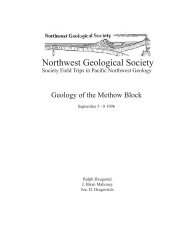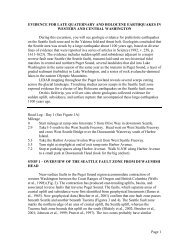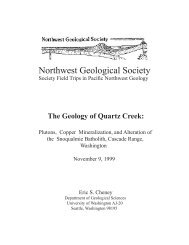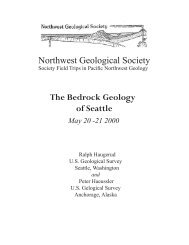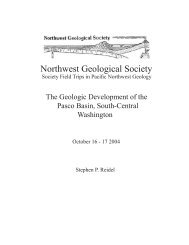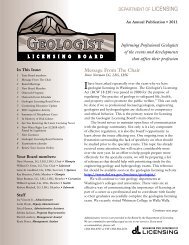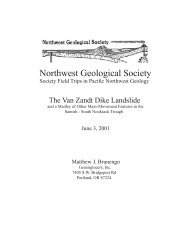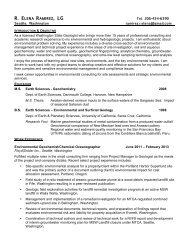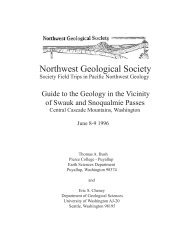Quaternary Geology of the Tacoma Area - Northwest Geological ...
Quaternary Geology of the Tacoma Area - Northwest Geological ...
Quaternary Geology of the Tacoma Area - Northwest Geological ...
You also want an ePaper? Increase the reach of your titles
YUMPU automatically turns print PDFs into web optimized ePapers that Google loves.
<strong>Northwest</strong> <strong>Geological</strong> Society<br />
Society Field Trips in Pacific <strong>Northwest</strong> <strong>Geology</strong><br />
<strong>Quaternary</strong> <strong>Geology</strong> <strong>of</strong> <strong>the</strong> <strong>Tacoma</strong><br />
<strong>Area</strong><br />
June 26 - 27 1999<br />
Kathy G. Troost<br />
Derek B. Booth<br />
Patrick Pringle
This field trip guide has been re-formatted from<br />
<strong>the</strong> original document produced by <strong>the</strong> authors.<br />
All <strong>the</strong> original text and illustrations are reproduced<br />
here, and nothing has been added to <strong>the</strong><br />
document in this process. All figures and images<br />
are reproduced at <strong>the</strong> same size as in <strong>the</strong> original<br />
document. 1<br />
NWGS Field Guides are published by <strong>the</strong> Society<br />
with <strong>the</strong> permission <strong>of</strong> <strong>the</strong> authors, permission<br />
which is granted for personal use and<br />
educational purposes only. Commercial reproduction<br />
and sale <strong>of</strong> this material is prohibited.<br />
The NWGS assumes no responsibility for <strong>the</strong><br />
accuracy <strong>of</strong> <strong>the</strong>se guides, or for <strong>the</strong> author’s authority<br />
to extend permission for <strong>the</strong>ir use.<br />
Of particular note, some stops on <strong>the</strong>se trips<br />
may be located on private property. Publication<br />
<strong>of</strong> this guide does not imply that public access<br />
has been granted to private property. If <strong>the</strong>re<br />
is a possibility that <strong>the</strong> site might be on private<br />
property, you should assume that this is <strong>the</strong> case.<br />
Always ask permission before entering private<br />
property.<br />
*Note- Some images in this guide have been slightly reduced in size to fit format requirements
<strong>Quaternary</strong> Stratigraphy <strong>of</strong> <strong>the</strong> <strong>Tacoma</strong> <strong>Area</strong><br />
Correlation and chronology <strong>of</strong> <strong>Quaternary</strong> deposits in <strong>the</strong> <strong>Tacoma</strong><br />
area has long been a source <strong>of</strong> frustration for those working<br />
in <strong>the</strong> area. Much field and laboratory research, utilizing<br />
radiocarbon dating, paleomagnetic studies, tephrochronology,<br />
bulk geochemistry, <strong>the</strong>rmoluminescence dating, fission track<br />
dating, and pollen and diatom analyses, is underway to establish<br />
<strong>the</strong> chronology and distribution <strong>of</strong> <strong>the</strong>se and o<strong>the</strong>r critical <strong>Quaternary</strong><br />
deposits. In addition, efforts are underway to confirm<br />
correlation <strong>of</strong> units here with <strong>the</strong> well-developed stratigraphy <strong>of</strong><br />
sou<strong>the</strong>ast and nor<strong>the</strong>rn Puget Sound (see strati graphic column).<br />
Most <strong>of</strong> <strong>the</strong> chronologic work on <strong>Quaternary</strong> stratigraphy has<br />
been accomplished by Easterbrook (1994) and his co-researchers.<br />
He compiled <strong>the</strong> following stratigraphic section for <strong>the</strong><br />
Puget Lowland. Note that <strong>the</strong>re is no “named” Olympia-age<br />
deposit on this section:<br />
The field trip will visit newly measured sections that span <strong>the</strong><br />
Steilacoom Gravel <strong>of</strong> <strong>the</strong> Vashon Drift through deposits tentatively<br />
correlated with <strong>the</strong> Puyallup Formation. Emphasis will be<br />
on stratigraphic relationships and <strong>Quaternary</strong> history, evidence<br />
(or lack) <strong>of</strong> tectonic deformation, variability within individual<br />
strata, and impacts to local and regional groundwater patterns.<br />
Regional Geologic Setting<br />
The sou<strong>the</strong>rn Puget Lowland has been glaciated at<br />
least six times during <strong>the</strong> Pleistocene Epoch (Easterbrook,<br />
1994). The most recent, during <strong>the</strong> Vashon<br />
Stade <strong>of</strong> <strong>the</strong> Fraser Glaciation, was marked by <strong>the</strong><br />
advance and retreat <strong>of</strong> <strong>the</strong> Puget Lobe <strong>of</strong> <strong>the</strong> Cordilleran<br />
Ice Sheet in western Washington. The glacier<br />
reached <strong>the</strong> central Puget Sound region about 15,000<br />
14C years BP and retreated past this area by 13,650<br />
14C years BP. Nonglacial deposits, where present,<br />
separate deposits <strong>of</strong> one glacier advance from ano<strong>the</strong>r.<br />
Because <strong>the</strong> coastal mountains <strong>of</strong> British Columbia<br />
were <strong>the</strong> source area for each <strong>of</strong> <strong>the</strong> ice sheet advances,<br />
macroscopic lithology cannot be used to identify<br />
or differentiate <strong>the</strong> deposits <strong>of</strong> one glacial period from<br />
ano<strong>the</strong>r glacial period. Because <strong>the</strong> Cascade volcanoes<br />
were primary sediment source areas during each nonglacial<br />
period in <strong>the</strong> <strong>Tacoma</strong> area, sediment lithology<br />
is probably not useful as a basis for differentiating<br />
<strong>the</strong> deposits <strong>of</strong> one nonglacial interval from those <strong>of</strong><br />
ano<strong>the</strong>r.<br />
nonglacial deposits. Note that some <strong>of</strong> <strong>the</strong> criteria only work<br />
in <strong>the</strong> south part <strong>of</strong> <strong>the</strong> Lowland.<br />
During glacial periods <strong>the</strong> apparent source <strong>of</strong> sediments is<br />
displaced to <strong>the</strong> north relative to nonglacial periods. In <strong>the</strong><br />
<strong>Tacoma</strong> area, nonglacial sediments are predominantly derived<br />
from Mount Rainier and proto-Mount Rainier to <strong>the</strong> sou<strong>the</strong>ast<br />
(see Table 3 below from Noble and Wallace, 1966). Glacial<br />
sediments, however, are dominated by lithologies with<br />
sources from <strong>the</strong> central and north Cascades more than 30<br />
miles north. Similarly, nonglacial sediments that are exposed<br />
along Hood Canal on <strong>the</strong> western margin <strong>of</strong> <strong>the</strong> lowland are<br />
predominantly composed <strong>of</strong> lithologies from <strong>the</strong> Olympic<br />
Mountains, but glacial sediments are predominantly derived<br />
from <strong>the</strong> North Cascades (Borden, 1998). In <strong>the</strong> Seattle area<br />
during nonglacial times, rivers carry sediments from both <strong>the</strong><br />
Mt. Rainier area and <strong>the</strong> central Cascades. These relationships<br />
are probably valid for glacial and nonglacial sediments<br />
throughout <strong>the</strong> lowland, although it may be locally complicated<br />
by <strong>the</strong> reworking <strong>of</strong> older glacial sediments during<br />
interglacial periods. Fur<strong>the</strong>rmore, <strong>the</strong> percentage <strong>of</strong> land area<br />
receiving deposition is small during nonglacial periods rela-<br />
Field Identification <strong>of</strong> Nonglacial Deposits<br />
Field recognition <strong>of</strong> nonglacial deposits depends<br />
heavily on <strong>the</strong> ability to differentiate glacial from<br />
nonglacial deposits. Because <strong>of</strong> <strong>the</strong> mixing that results<br />
from reworking <strong>of</strong> underlying deposits during a<br />
glacier advance and erosional/sedimentation cycles,<br />
differentiation <strong>of</strong> glacial from nonglacial deposits<br />
is unavoidably ambiguous. For end-member cases,<br />
however, several distinguishing characteristics are as<br />
follows. The following table (Troost and o<strong>the</strong>rs, 1998)<br />
summarizes <strong>the</strong> criteria for differentiating glacial from
tive to glacial periods, as shown on <strong>the</strong> figure on <strong>the</strong> following<br />
page from Borden and Troost (1999).
CITATIONS AND OTHER REFERENCES<br />
Anundsen, K., Abella, S., Leopold, E., Stuiver, M., and Turner,<br />
S., 1994, Late-glacial and early Holocene sea-level fluctuations<br />
in <strong>the</strong> central Puget Lowland, Washington, inferred from<br />
lake sediments: <strong>Quaternary</strong> Research, v. 42, p. 149-161.<br />
Armstrong, J.E., Crandell D.R., Easterbrook, D.J., and Noble<br />
J.B., 1965, Late Pleistocene stratigraphy and chronology in<br />
southwestern British Columbia and northwestern Washington:<br />
<strong>Geological</strong> Society <strong>of</strong> America Bulletin, v. 76, p. 321-330.<br />
Beget, J.E., Keskinen, M.J., and Severin, K.P., 1997, Tephrochronologic<br />
constraints on <strong>the</strong> Late Pleistocene history<br />
<strong>of</strong> <strong>the</strong> sou<strong>the</strong>rn margin <strong>of</strong> <strong>the</strong> Cordilleran ice sheet, western<br />
Washington: <strong>Quaternary</strong> Research, v. 47, p. 140-146.<br />
Blunt D.J., Easterbrook, D.J., and Rutter, N.W., 1987, Chronology<br />
<strong>of</strong> Pleistocene sediments in <strong>the</strong> Puget Lowland, Washington:<br />
Washington Division <strong>of</strong> <strong>Geology</strong> and Earth Resources<br />
Bulletin 77, p. 321-353.<br />
Booth, D.B., 1987, Timing and processes <strong>of</strong> deglaciation along<br />
<strong>the</strong> sou<strong>the</strong>rn margin <strong>of</strong> <strong>the</strong><br />
Cordilleran ice sheet: In W.F. Ruddimann and H.E. Wright, Jr.,<br />
eds., “North America and adjacent oceans during <strong>the</strong> last deglaciation”<br />
Boulder, Colorado, <strong>Geological</strong> Society <strong>of</strong> America,<br />
<strong>Geology</strong> <strong>of</strong> North America, v. K-3, p. 71-90.<br />
Booth, D. B., 1994, Glaci<strong>of</strong>luvial infilling and scour <strong>of</strong> <strong>the</strong><br />
Puget Lowland, Washington, during ice-sheet glaciation: <strong>Geology</strong>,<br />
v. 22, p. 695-698.<br />
Borden, R.K., and Troost, K.G., 1999 (in re<br />
view), Late Pleistocene Stratigraphy in <strong>the</strong> south-central Puget<br />
Lowland, West-Central Pierce County, Washington: Olympia,<br />
Washington State Department <strong>of</strong> Natural Resources, Open-<br />
File Report.<br />
Crandell, D. R., Mullineaux, D. R., and Waldron, H. H., 1958,<br />
Pleistocene sequence in <strong>the</strong><br />
sou<strong>the</strong>astern part <strong>of</strong> <strong>the</strong> Puget Sound Lowland, Washington:<br />
American Journal <strong>of</strong> Science, v. 256, p. 384-397.<br />
Deeter, J.D., 1979, <strong>Quaternary</strong> geology and stratigraphy <strong>of</strong><br />
Kitsap County, Washington. Unpub M.S. <strong>the</strong>sis, Western<br />
Washington University.<br />
Dethier, D.P., Pessl, F., Keuler, R.F., Balzarini, M.A., and<br />
Pevear, D.R., 1995, Late Wisconsinan glaciomarine deposition<br />
and isostatic rebound, nor<strong>the</strong>rn Puget Lowland, Washington:<br />
<strong>Geological</strong> Society <strong>of</strong> America Bulletin, v. 107, p. 1288-1303.<br />
Easterbrook, D.J., 1994, Chronology <strong>of</strong> pre-late Wisconsin<br />
Pleistocene sediments in <strong>the</strong> Puget Lowland, Washington:<br />
Washington Division <strong>of</strong> <strong>Geology</strong> and Earth Resources Bulletin<br />
80, p. 191-206.<br />
Easterbrook, D. J., Crandell, D. R., and Leopold, E. B., 1967,<br />
Pre-Olympia Pleistocene stratigraphy and chronology in <strong>the</strong><br />
central Puget Lowland, Washington: <strong>Geological</strong> Society <strong>of</strong><br />
America Bulletin, v. 78, p. 13-20.<br />
Garling, M. E., Molenaar, D., Bailey, E. G., VanDenburgh, A.<br />
S., and Fiedler, G. H., 1965, Water resources and geology <strong>of</strong> <strong>the</strong><br />
Kitsap Peninsula and certain adjacent islands: Washington Division<br />
<strong>of</strong> Water Resources Water-Supply Bulletin 18, 309 p.<br />
Leopold, E.B., Nickmann, R., Hedges, J.I., and Ertel, J.R., 1982,<br />
Pollen and lignin records <strong>of</strong> late <strong>Quaternary</strong> vegetation, Lake<br />
Washington: Science, v. 218, p. 1305-1307.<br />
Mullineaux, D.R., Waldron, H.H., and Rubin, M., 1965, Stratigraphy<br />
and chronology <strong>of</strong> late<br />
interglacial and early Vashon time in <strong>the</strong> Seattle area, Washington:<br />
U. S. <strong>Geological</strong> Survey Bulletin 1194-O, 10 p.<br />
Mullineaux, D.R., 1996, Pre-1980 tephra-fall deposits erupted<br />
from Mount St. Helens, Washington: U.S. <strong>Geological</strong> Survey<br />
Pr<strong>of</strong>essional Paper 1563, 99 p.<br />
Noble, J.B., and Wallace, E.F., 1966, <strong>Geology</strong> and ground-water<br />
resources <strong>of</strong> Thurston County, Washington: Washington Division<br />
<strong>of</strong> Water Resources Water-Supply Bulletin No. 10, vol. 2,<br />
141 p.<br />
Porter, S. C., and Swanson, T. W., 1996, Radiocarbon constraints<br />
on rates <strong>of</strong> advance and retreat <strong>of</strong> <strong>the</strong> Puget lobe during<br />
<strong>the</strong> last glaciation in <strong>the</strong> sou<strong>the</strong>astern Puget Lowland: <strong>Quaternary</strong><br />
environmental changes in <strong>the</strong> Pacific <strong>Northwest</strong>, Abstracts<br />
and program, University <strong>of</strong> Washington <strong>Quaternary</strong> Research<br />
Center Spring 1996 Workshop, p. 15.<br />
Rigg, G.B., and Gould, H.R., 1957, Age <strong>of</strong> Glacier Peak eruption<br />
and chronology <strong>of</strong> postglacial peat deposits in Washington<br />
and surrounding areas: American Journal <strong>of</strong> Science, v. 255, p.<br />
341-363.<br />
Smith M., 1972, Stratigraphy and chronology <strong>of</strong> <strong>the</strong> <strong>Tacoma</strong><br />
area, Washington. Unpub. M.S. <strong>the</strong>sis, Western Washington<br />
University.<br />
Troost, K.G., Booth, D.B., Sarna-Wojcicki, A., Meyer, C.E., and<br />
Hagstrum, J.T., 1997,<br />
“Chronology, Mineralogy, and Correlation <strong>of</strong> <strong>Quaternary</strong> Tephra<br />
and Mudflow Deposits in <strong>the</strong> Central Puget Lowland, Washington<br />
State”. In Abstracts with Programs, 1997 Annual Meeting,<br />
<strong>Geological</strong> Society <strong>of</strong> America, Salt Lake City, Utah, p. A-411.<br />
Troost, K.G., Mahoney, J.B., Booth, D.B., and Borden, R.K.,<br />
1998, Discriminating glacial from nonglacial sediments <strong>of</strong> <strong>the</strong><br />
south-central Puget Lowland: Program with Abstracts, Annual<br />
Meeting, Seattle, WA, Sept 30-Oct 3, Association <strong>of</strong> Engineering<br />
Geologists, p. 130.
Walsh, T.J., 1987, Geologic map <strong>of</strong> <strong>the</strong> south half <strong>of</strong> <strong>the</strong> <strong>Tacoma</strong><br />
quadrangle, Washington: Washington Division <strong>of</strong> <strong>Geology</strong> and<br />
Earth Resources Open File Report 87-3, 1:100,000.<br />
Walters, K.L. and G.E. Kimmel, 1968, Ground-Water occurrences<br />
and stratigraphy <strong>of</strong><br />
unconsolidated deposits, Central Pierce County, Washington:<br />
Washington Department <strong>of</strong> Water Resources Water Supply Bulletin<br />
22, 428 p.<br />
NEW GEOLOGIC MAPS OF THE TACOMA AREA IN<br />
PRESS, REVIEW, OR PREPARATION:<br />
Booth, D.B., and Troost, K.G., in review (submitted 12/98), Geologic<br />
map <strong>of</strong> <strong>the</strong> Olalla 7.5-minute quadrangle, Washington: U. S.<br />
<strong>Geological</strong> Survey, Open-File Report, scale 1:24,000.<br />
Booth, D. B., and Waldron, H. H., in press, Surficial Geologic<br />
Map <strong>of</strong> <strong>the</strong> Des Moines 7.5’ Quadrangle, King County, Washington:<br />
U.S. <strong>Geological</strong> Survey Open-File Series Map, scale<br />
1:24,000, 1 sheet, text.<br />
Booth, D.B., Waldron, H.H., and Troost, K.G., in press, Geologic<br />
map <strong>of</strong> <strong>the</strong> Poverty Bay 7.5-minute quadrangle, Washington: U.<br />
S. <strong>Geological</strong> Survey, Open-File Report, scale 1:24,000.<br />
Troost, K.G., in review (submitted 1/99), Geologic map <strong>of</strong> <strong>the</strong><br />
Puyallup 7.5-minute quadrangle, Washington: U. S. <strong>Geological</strong><br />
Survey, Open-File Report, scale 1:24,000.<br />
Troost, K.G., in review (submitted 10/97), Geologic map <strong>of</strong> <strong>the</strong><br />
<strong>Tacoma</strong> South 7.5-minute quadrangle, Washington: U. S. <strong>Geological</strong><br />
Survey, Open-File Report, scale 1:24,000.<br />
Troost, K.G. and Booth, D.B., in preparation (submission for<br />
review 12/99), Geologic map <strong>of</strong> <strong>the</strong> Gig Harbor 7.5-minute quadrangle,<br />
Washington: U. S. <strong>Geological</strong> Survey, Open-File Report,<br />
scale 1:24,000.<br />
Troost, K.G. and Booth, D.B., in review (submitted 1/99), Geologic<br />
map <strong>of</strong> <strong>the</strong> <strong>Tacoma</strong> North 7.5-minute quadrangle, Washington:<br />
U. S. <strong>Geological</strong> Survey, Open-File Report, scale 1:24,000.<br />
Troost, K.G., Booth, D.B., and Borden, R.K., in review (submitted<br />
10/97), Geologic map <strong>of</strong> <strong>the</strong> Steilacoom 7.5-minute quadrangle,<br />
Washington: U. S. <strong>Geological</strong> Survey, Open-File Report,<br />
scale 1:24,000.
This locality displays a classic relationship between <strong>the</strong> main Vashon glacial units. The Vashon till (Qvt)<br />
drapes <strong>the</strong> upland surface, but it has been locally eroded by <strong>the</strong> action <strong>of</strong> recessional meltwater (leaving deposit<br />
Qvr). Nalley Valley is one <strong>of</strong> <strong>the</strong> major channels that connected different arms <strong>of</strong> <strong>the</strong> proglacial recessional<br />
lake that drained through progressively lower spillways into Lake Russell, and from <strong>the</strong>re south over<br />
<strong>the</strong> Black Hills into <strong>the</strong> Chehalis River. Beneath <strong>the</strong> recessional and till lies sand and gravel <strong>of</strong> <strong>the</strong> Vashon<br />
advance outwash (Qva), which constitues most <strong>of</strong> <strong>the</strong> topographic relief present in <strong>the</strong> modern landscape.
In <strong>the</strong> <strong>Tacoma</strong> area, multiple recessional channels served as “spillways,” allowing water to drain southwest<br />
from glacial Lake Puyallup into <strong>the</strong> main proglacial lake along <strong>the</strong> axis <strong>of</strong> <strong>the</strong> Puget Lowland (glacial Lake<br />
Russell) and <strong>the</strong>nce out through <strong>the</strong> Black Hills and into <strong>the</strong> Chehalis River. The following figure (from<br />
Walters and Kimmel, 1968) shows <strong>the</strong> locations <strong>of</strong> some <strong>of</strong> <strong>the</strong> more pronounced channels linking <strong>the</strong> two<br />
glacial lakes. As <strong>the</strong> ice receded to <strong>the</strong> north, progressively lower channels were exposed and so were occupied<br />
by meltwater.



